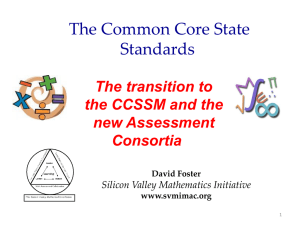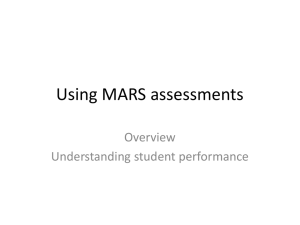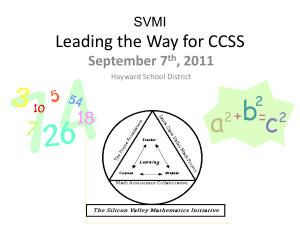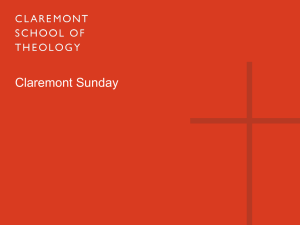part 1 - Silicon Valley Mathematics Initiative
advertisement
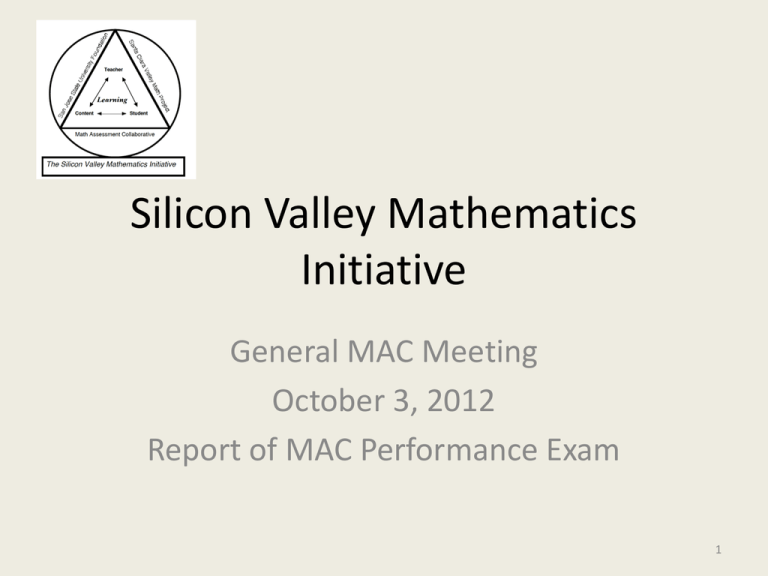
Silicon Valley Mathematics Initiative General MAC Meeting October 3, 2012 Report of MAC Performance Exam 1 Silicon Valley Mathematics Initiative 87 Members - School Districts, Charter School Networks, and Schools Albany USD Alvord SD (Riverside County) Antioch Unified SD Aspire Charter School Network Assumption School (San Leandro) Bayshore SD Belmont-Redwood Shores SD Berryessa SD Bolinas – Lagunitas SD Brisbane SD Buckeye SD Cambrian SD Campbell Union ESD Castro Valley USD Charter School of Morgan Hill Chicago Public School Creative Arts Charter (SF) CSU San Bernardino Cotati – Rohnert Park Cupertino SD Dade County Schools (GA) Del Mar USD (San Diego Co) Discovery Charter School Dioceses of Santa Clara Dublin USD East Side UHSD Edmonds Community College Emery SD Etiwanda SD (San Bernardino Co) Gilroy (Brownell MS) Fairfield-Suisun USD Fremont USD Forsyth County School (GA) Hamilton County (Tn) Hayward USD Jefferson ESD Jefferson HSD Las Lomitas SD La Honda-Pescadero Sd Livermore USD Los Altos SD Los Gatos SD Menlo Park SD Monterey Peninsula USD Moreland SD Mountain SD National Council of La Raza New York City PS New Visions for Public Schools Oakland Unified SD Pacifica SD Pajaro Valley USD Palo Alto USD Pittsburgh USD Portola Valley SD Ravenswood City SD Riverside COE Redwood City Schools Sacramento City USD Valdosta City (GA) Salinas City Schools Walnut Creek SD San Carlos CLC Woodside SD San Diego COE San Diego Unified School District San Francisco USD SMFC (Park School) San Jose Unified SD San Leandro USD San Ramon Valley USD Santa Clara USD Santa Cruz City Schools Saint Michael’s School (Poway) Saint Patrick’s School (San Jose) Saratoga Scotts Valley USD SCCOE County Court Schools Sequoia HSD SMCOE County Court Schools South Cook Service District South San Francisco USD Supporting Sumter County (GA) Teaching and The Nueva School Learning of Union SD 2 University of Illinois, Chicago Mathematics Since 1996 Valley Christen (Dublin) Three Central Authors Common Core State Standards in Mathematics Bill McCallum Phil Daro Jason Zimba Charges given to the authors: • All students College and Career Ready by 11th grade • Internationally Benchmarked • Make the standards “Fewer, Clear and Higher” 3 4 Mathematical Practice 1. Make sense of problems and persevere in solving them. 2. Reason abstractly and quantitatively. 3. Construct viable arguments and critique the reasoning of others. 4. Model with mathematics. 5. Use appropriate tools strategically. 6. Attend to precision. 7. Look for and make use of structure. 8. Look for and express regularity in repeated reasoning. 5 REASONING AND EXPLAINING 1. Make sense of problems and persevere in solving them 6. Attend to precision OVERARCHING HABITS OF MIND CCSS Mathematical Practices 2. Reason abstractly and quantitatively 3. Construct viable arguments and critique the reasoning of others MODELING AND USING TOOLS 4. Model with mathematics 5. Use appropriate tools strategically SEEING STRUCTURE AND GENERALIZING 7. Look for and make use of structure 8. Look for and express regularity in repeated reasoning 6 Practices for Next Generation Science Standards 1. Asking questions (for science) and defining problems (for engineering) 2. Developing and using models 3. Planning and carrying our investigations 4. Analyzing and interpreting data 5. Using mathematics and computational thinking 6. Constructing explanations (for science) and designing solutions (for engineering) 7. Engaging in argument from evidence 8. Obtaining, evaluating and communicating information 7 Common Core State Standards for English Language Arts Reading: text complexity and the growth of comprehension The Reading standards place equal emphasis on the sophistication of what students read and the skill with which they read. Standard 10 defines a grade-by- grade “staircase” of increasing text complexity that rises from beginning reading to the college and career readiness level. Whatever they are reading, students must also show a steadily growing ability to discern more from and make fuller use of text, including making an increasing number of connections among ideas and between texts, considering a wider range of textual evidence, and becoming more sensitive to inconsistencies, ambiguities, and poor reasoning in texts. Writing: text types, responding to reading, and research The Standards acknowledge the fact that whereas some writing skills, such as the ability to plan, revise, edit, and publish, are applicable to many types of writing, other skills are more properly defined in terms of specific writing types: arguments, informative/explanatory texts, and narratives. Standard 9 stresses the importance of the writingreading connection by requiring students to draw upon and write about evidence from literary and informational texts. Because of the centrality of writing to most forms of inquiry, research standards are prominently included in this strand, though skills important to research are infused throughout the document. Speaking and Listening: flexible communication and collaboration Including but not limited to skills necessary for formal presentations, the Speaking and Listening standards require students to develop a range of broadly useful oral communication and interpersonal skills. Students must learn to work together, express and listen carefully to ideas, integrate information from oral, visual, quantitative, and media sources, evaluate what they hear, use media and visual displays strategically to help achieve communicative purposes, and 8 adapt speech to context and task. A FLU NT 3x2 – y = π 9 The California Algebra Experiment • In 2012, 59% of all eighth grade students took the CST Algebra 1 exam and more than half were not successful. Even more will repeated the class again in high school. • In 9th grade, 49% of the students took CST Algebra 1 exam and 75% of those students did not pass. • Research studies indicate nearly 65% of the students who were placed in Algebra in eighth grade are placed in the same level of Algebra in ninth grade. • About 46% of the students who were successful in Algebra in the eighth grade (B- grade and Proficient) and who were placed again in Algebra in ninth grade were less successful in their second experience. It is Algebra Forever not Algebra for All 10 New K-12 Math Curriculum Inspired by The Common Core State Standards The Gates Foundation and the Pearson Foundation are funding a large scale project to create a system of courses to support the ELA and Mathematics CCSS. These will be a modular, electronic curriculum spanning all grade levels. A Santa Cruz based company, Learning In Motion, is working to write the lessons. 11 Think in Terms of Units Phil Daro has suggested that it is not the lesson or activity, but rather the unit that is the “optimal grain-size for the learning of mathematics”. Hence that was the starting point for our Scope and Sequence. Developers of High School: Patrick Callahan, Dick Stanley, David Foster, Brad Findell, Phil Daro, and Marge Cappo 12 13 Middle School Curriculum 14 CCSS High School Units High School Algebra Units: A0 Introductory Unit A1 Modeling with Functions A2 Linear Functions A3 Linear Equations and Ineq in One Var A4 Linear Equations and Ineq in Two Var A5 Quadratic Functions A6 Quadratic Equations A7 Exponential Functions A8 Trigonometric Functions A9 Functions A10 Rational and Polynomial Expressions High School Geometry Units: G0 Introduction and Construction G1 Basic Definitions and Rigid Motions G2 Geometric Relationships and Properties G3 Similarity G4 Coordinate Geometry G5 Circle and Conics G6 Trigonometric Ratios G7 Geometric Measurement and Dimension M4 Capstone Geometric Modeling Project High School Prob & Stat Units: P1 Probability S1 Statistics S2 Statistics (Random Process) 15 T R A D I T I O N A L 16 I N T E G R A T E D 17 CCSSM 8th Grade are HS Standards • Algebra/Functio ns 67% • Geometry (Transformations and 20% • Bivariate Data 10% • Cross-Concept Project 3% Triangle Proofs) 18 When do we Accelerate????? 19 Where to Accelerate? Can we live without understanding…. Integer and their operations Division of Fractions Ratio and proportional reasoning Expression, Equations and Inequalities Statistics 20 Where to Accelerate? Can we live without understanding…. Properties of rational numbers, percents, discounts, markups, etc. Rate and problems solving using rate Similarity, proportional reasoning Algebraic Modeling with Equations Probability Geometry: Angles, Volume, Surface Area, 3-D shapes 21 When do they Accelerate in Japan? After th 8 Grade!!!!!!! 22 Where to Accelerate???? 23 When do we Accelerate????? The Only Reasonable Answer for Learning: 9th Grade!!!! 24 25 CST – Released Items Algebra 1 26 The design of scaffolded performance assessment tasks Top Core Core Ramp Access 27 Apprentice Task 28 29 30 Performance Assessments To Inform Instruction And Measure Higher Level Thinking Top Task Design Core Ramp Access Entry level (access into task) Core Mathematics - (meeting standards) Top of Ramp (conceptually deeper, beyond) • • The Mathematics Assessment Resource Service (MARS) is an NSF funded collaboration between U.C. Berkeley and the Shell Centre in Nottingham England. The Assessments target grades 2- Geometry and are aligned with the State and NCTM National Math Standards. 31 Performance Exams 40,000 – 70,000 students per year since 1999 Students in grades 2 through 10th/11th grade are administered performance exams (5 apprentice tasks per exam). Student results are collected, analyzed, and reported by an independent data contractor. Random sample of student papers are audited and rescored by SJSU math & CS students. (Two reader correlation >0.95) District scoring leaders are trained in using task specific rubrics Student tests are hand scored by classroom teachers trained and calibrated using standard protocols. 32 MAC vs. CST 2012 Silicon Valley Mathematics Initiative Mathematics Assessment Collaborative Performance Assessment Exam 2012 33 MAC vs CST 2012 2nd Grade MAC Level 1 MAC Level 2 MAC Level 3 MAC Level 4 Far Below Basic Below Basic Basic Proficient Advanced 2nd Grade CST Below CST At/Above Total 1.0% 1.9% 1.3% 0.4% 0.3% MAC Below 0.3% 2.4% 4.8% 3.5% 0.9% 0.1% 1.2% 5.5% 17.7% 23.4% MAC At/Above 0.0% 0.0% 0.3% 3.4% 31.4% Total 11.7% 7.1% 18.8% 5.1% 75.9% 81.0% 16.8% 83.0% 100% 34 Elementary Grades 3rd Grade CST Below CST At/Above Total 4th Grade CST Below CST At/Above Total 5th Grade CST Below CST At/Above Total MAC Below 15.9% 13.7% 29.6% MAC Below 16.9% 20.3% 37.2% MAC Below 20.6% 18.7% 39.3% MAC At/Above 5.2% 65.4% 70.6% MAC At/Above 2.8% 60.0% 62.8% MAC At/Above 3.8% 56.9% 60.7% Total 21.1% 79.1% 100% Total 19.7% 80.3% 100% Total 24.4% 75.6% 100% 35 Middle School 6th Grade CST Below CST At/Above Total 7th Grade CST Below CST At/Above Total Course 1 CST Below CST At/Above Total MAC Below 37.2% 25.1% 62.3% MAC Below 33.3% 27.4% 60.7% MAC Below 34.5% 30.3% 64.8% MAC At/Above 1.4% 36.5% 37.9% MAC At/Above 2.1% 37.1% 39.2% MAC At/Above 3.6% 31.5% 35.1% Total 38.6% 61.6% 100% Total 35.4% 64.5% 100% Total 38.1% 61.8% 100% 36 8th Graders Taking HS Geometry Course 2 MAC Below CST Below 3.1% MAC At/Above Total 0.8% 3.9% CST At/Above 51.3% 44.8% 96.1% Total 54.4% 45.6% 100% 37 Reports MAC Final Report District Reports Tools for Teachers A very special thanks to Linda Fisher 38 Thank You Linda Fisher, Director of Assessment and Author of Tools for Teachers and MAC Reports Sally Keyes, Director of Professional Development and Assessment Writer Melissa Adams, Assessment Writer Barbara Scott, Assessment Writer Mia Buljan, Author of Second Grade Tools for Teachers Rosita Fabian, Spanish Translations Donna Goldenstein, Assessment editing Sonya Montelongo, Educational Data Systems Cindy Chin, SVMI Office Manager (she does it all) MAC Trainers Jeff Trubey Sandy Devlin Jean Short Barbara Scott Debbie Borda Melissa Adams Kristy Leo Margie TrainerSally Keyes Carol Hatalsky Ford Long Priscilla Solberg Mia Buljan 39 Professional Development Opportunities 2012-2013 Silicon Valley Mathematics Initiative www.svmimac.org David Foster Silicon Valley Mathematics Initiative www.svmimac.org 40 • SVMI’s Resources and Programs Professional Development Math Talks Summer Institutes and Math Workshops throughout the school year. Problems of the Month Promoting Classroom Discourse and Conceptual Understanding Performance Assessments School-wide Problem Solving Math Coaching Lesson Study Project Math Network Meetings and Workshops for Coaches and Principals School Team Mini - Grants 41 SVMI Professional Development Sep, Oct, Nov, Dec, Jan • • • • • San Mateo Co. (TBA) Santa Clara Co. (SJUSD BR) Santa Cruz Co. (TBA) Alameda Co. (OUSD Tilden) Tri-Valley Area (Dublin BR) 42 SVMI Calendar 2012-13 • • • • • • • • May & June 2012: the SCVMP Leadership Institute August 2012: The 13th Annual Coaching Institute and East Bay Sep. – May 2012-2013: Math Network Meeting for Math Coaches Sep. – Jan : Five Professional Development Workshops (K-Algebra) Sep. – Jan: Lesson Study Project Dec. & Feb. Principal Leader Meetings March 2013: Administer the annual MAC performance exam District Administrator Meetings: October, February, May 43 This site gets 10,000 hits each week. 6,000 to download POMs. 44 45 Curriculum inspired by the CCSS MAP’s Formative Assessment Lessons and Professional Development Modules Assessment For Learning Formative Assessment Lessons (2 days) for High School and Middle School 46 47 Inside Mathematics Website http://www.insidemathematics.org Mathematics Assessment Project UC Berkeley & Shell Centre for Mathematical Education http://map.mathshell.org/materials/lessons.php Silicon Valley Mathematics Initiative http://www.svmimac.org 48 Understanding the Data MAC Administrative Reports 49 Setting The Level Boundaries pg. 9 or 10 • Analysis of the tasks and rubrics in relation to the Standards - What is the grade level mathematics? • Holistic judgment of sample papers around provisional level - Does this student performance, viewed as a whole, meet the standard? • Statistical distribution for the task and test 50 Comparing Student Performance • Different tests each year - sample of standards/ not parallel tests • Different student populations - 2005 eighth graders in Algebra, this year high school in geometry • 2012 first year with Common Core State Standards 51 Comparing Student Performance 52 Comparing Student Performance • • • • • Shows the years 2005 to 2012 Gives the number of students tested Gives the percentage at each level Describes trends Stayed the same: Second at 82.5%, Third at 70.1%, Eighth at 25.9% 53 Comparing Student Performance Improving • Seventh - from 23.7% to 38.7% Declining • Fourth - from 71.5% to 62.2% • Fifth - from 76.5% to 60.6% • Sixth - from 43.2% to 38% • Algebra- from 46% to 34.5% • Geometry - from 50% to 24.6% 54

